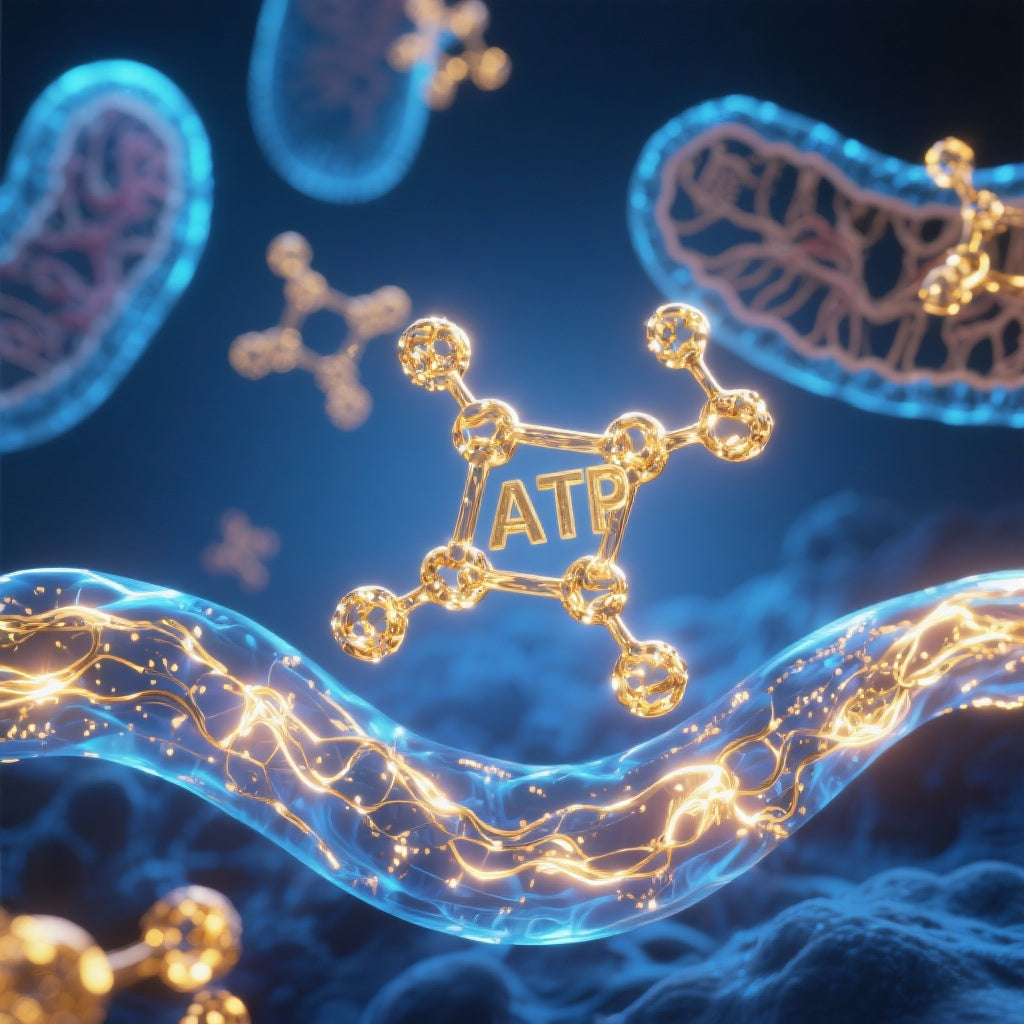What is ATP? The miracle molecule that powers your cells
Have you ever felt exhausted, even after a full night's sleep? Struggled to find the energy to concentrate or finish your workout? This feeling of fatigue isn't just in your head. It's deeply rooted in the biology of your cells. The key to this energy, this vitality that drives us, lies in a tiny but incredibly powerful molecule: Adenosine Triphosphate , or ATP.
Think of ATP as the universal currency of energy in your body. Every movement, every thought, every heartbeat uses this precious currency. Understanding how it works is the key to unlocking energy levels you never knew existed. In this comprehensive guide, we'll delve into the heart of your cells to demystify ATP, understand how your body produces it, and, most importantly, how you can optimize this process to live a more energetic and vibrant life.
ATP: Your Body's Energy Currency
To grasp the importance of ATP, let's use a simple analogy. Think of your body as a bustling city. For the lights to stay on, the factories to run, and the transportation to function, the city needs a constant source of energy: electricity. For your cells, ATP is that electricity. It's the direct fuel that powers almost all cellular activity.
Chemically, the structure of adenosine triphosphate is simple yet ingenious. It consists of three parts:
- Adenine : A nitrogenous base that is also found in our DNA.
- Ribose : A sugar with five carbon atoms.
- Three phosphate groups : This is where the magic lies. The bonds that unite these three groups are extremely energy-rich.
When your body needs energy to contract a muscle, synthesize a protein, or transmit a nerve impulse, it breaks the last phosphate bond of the ATP molecule. This break releases a burst of usable energy, converting ATP into adenosine diphosphate (ADP) and an inorganic phosphate. This constant cycle of breaking and reforming fuels life.
The ATP Cycle: A Perpetual Cellular Engine
The human body doesn't store large amounts of ATP. In fact, you only have about 85 grams of ATP at any given time, enough for just a few seconds of intense effort. So how do we manage to function all day? The answer is a phenomenally efficient recycling process.
"The human body is an incredible energy recycling machine. Every day, an average adult produces and breaks down their own body weight into ATP. It's a relentless cycle that never stops."
ADP (the "uncharged" version) is rapidly "recharged" into ATP. This recharging occurs primarily thanks to the energy we extract from the food we eat (carbohydrates, fats, and proteins). This process, called phosphorylation , attaches a phosphate group to ADP, converting it back into ATP, ready to be used again. This ATP-ADP cycle occurs billions of times per second in every cell of your body. It is the true engine of life, a perfectly orchestrated biochemical ballet.
Where is ATP produced? A journey to the heart of the mitochondria
If ATP is the energy currency, then mitochondria are the power plants of our cells. These tiny organelles are the primary sites of ATP production. The more energy-intensive a tissue or organ is (such as the brain, heart, or muscles), the richer its cells are in mitochondria.
ATP production in mitochondria occurs via a complex process called cellular respiration . Without going into too much technical detail, it can be broken down into three main stages:
- Glycolysis: Takes place in the cytoplasm of the cell and breaks down glucose into smaller molecules, generating a small amount of ATP.
- The Krebs Cycle: Takes place inside the mitochondria. It uses the products of glycolysis to generate high-energy electron carriers.
- The Electron Transport Chain: This is the real ATP factory. The electron carriers of the Krebs cycle release their electrons, creating a flow that powers proton pumps. This proton gradient activates an incredible enzyme, ATP synthase, which produces massive amounts of ATP.
This process is a marvel of biological engineering, efficiently transforming the chemical energy of food into energy directly usable by our cells. To learn more about the pillars of health, visit our information blog .
Why is an optimal ATP level crucial for your well-being?
Maintaining healthy and efficient ATP production is not just a scientific concept; it has direct and profound repercussions on your quality of life. Optimal ATP production is synonymous with vitality and overall health.
Daily Energy and Vitality
This is the most obvious benefit. A good ATP level means you wake up refreshed, you get through your day with sustained energy, without the dreaded afternoon slump. You have the stamina to tackle your professional, personal, and social tasks with enthusiasm.
Physical Performance and Recovery
For athletes, ATP is the limiting factor in performance. Every muscle contraction, every sprint, every repetition consumes ATP. A greater ability to regenerate ATP allows for more intense and longer efforts, and faster recovery after exercise, because cellular repair processes are themselves very energy-intensive.
Cognitive Functions and Mental Clarity
Your brain, although it represents only 2% of your body weight, consumes approximately 20% of your total energy. This energy is used to maintain communication between neurons. High ATP levels promote concentration, memory, speed of thought, and mental clarity. Brain fog is often a sign of mitochondrial dysfunction.
Regeneration and Anti-Aging Process
Tissue repair, cell regeneration, and combating oxidative stress are processes that require a tremendous amount of energy. Healthy mitochondria producing sufficient ATP are essential for slowing down the aging process and maintaining the body in good working order.
How to Naturally Support Your ATP Production?
The good news is that you're not simply a passive observer of your energy production. Your lifestyle choices can significantly impact the efficiency of your mitochondria and your ability to produce ATP. Explore our lifestyle tips for a holistic approach.
Nutrient-Rich Nutrition
Your mitochondria need specific cofactors to function properly. Make sure you have an adequate intake of:
- B vitamins: Essential for many stages of energy metabolism.
- Magnesium: ATP must be bound to magnesium to be biologically active.
- Coenzyme Q10: An antioxidant and a crucial component of the electron transport chain.
- Omega-3 fatty acids: They contribute to the health of mitochondrial membranes.
Incorporate healthy and energizing recipes into your daily routine.
Regular Physical Exercise
Exercise, especially high-intensity interval training (HIIT) and endurance training, sends a powerful signal to your body to produce more mitochondria. This is a process called mitochondrial biogenesis . More mitochondria means a greater capacity to produce ATP.
The Role of Adaptogens and Minerals: The Case of Shilajit
Certain natural substances can play a remarkable supporting role in mitochondrial function. Shilajit , an ancient resin from the Himalayan mountains, is particularly noteworthy. Rich in fulvic acid and over 84 essential minerals, Shilajit is being studied for its ability to enhance ATP production.
Fulvic acid helps transport nutrients and minerals directly into cells, thus improving the efficiency of energy processes. Furthermore, Shilajit has demonstrated its ability to stabilize and enhance the efficiency of Coenzyme Q10, a key component in ATP production. By directly supporting mitochondrial health, Shilajit can contribute to a natural and sustained increase in cellular energy.
Ready to feed your mitochondria and awaken your energy?
Discover our PURVAL Shilajit Resin 30gConclusion: ATP, Your Daily Energy Ally
Adenosine Triphosphate is more than just a molecule; it's the very essence of your vitality. From the clarity of your thoughts to the power of your muscles, everything depends on your body's ability to efficiently produce and utilize this incredible cellular fuel. By adopting a nutrient-rich diet, an active lifestyle, and turning to natural supports like Shilajit, you give your mitochondria the tools they need to function at their full potential.
Remember that sustainable energy doesn't come from a miracle solution, but from consistently and intelligently supporting your body's fundamental processes. Take care of your cells, and they will take care of you. What's the first habit you'll adopt to boost your ATP?











